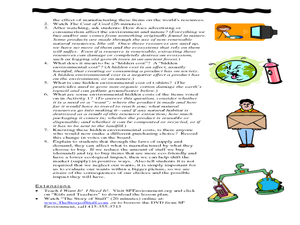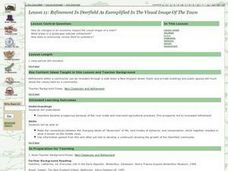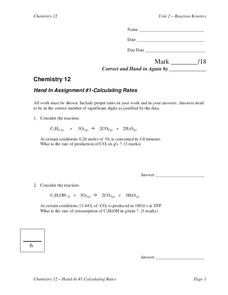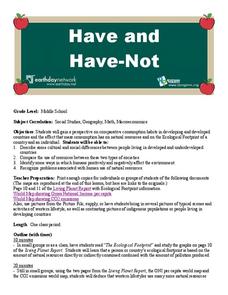Curated OER
WS 8.4 Percentage Problems
In this percentage instructional activity, students calculate percentages given various types of problems. They calculate percent of compounds in a solution, they calculate mass of compounds given percentages of solutions, and they...
Curated OER
Chapter 28: Red Flags and Velvet Revolutions: The End of the Cold War, 1960-1990
Set your historians up for testing success using this interactive flashcard tool. It is one of many learning strategies offered in this thorough online resource. Although designed for use with a text, the site is valuable independently....
Curated OER
Post-Modernism and Mass Culture
Students examine the suggestion that the subjective experience of everyday life and sense of identity has changed in America in recent years. In this post-modernism and mass culture lesson, students engage in 4 multi-step exercises that...
Global Oneness Project
Deconstructing Consumerism
To increase awareness and launch a discussion of consumerism, class members view What Would It Look Like, a 25 minute film of images that capture the global effects of the consumption of goods. Viewers make a list of the images that they...
Film English
iDiots
Mobile phones have become an integral part of many people's lives. Examine the role and impact of technology through a short video and related activities. Pupils share what they use their phones for before viewing the film. Class members...
University of Texas
What Are Calories?
What are calories, and how do calorie needs differ from person to person? Here is a worksheet that briefly explains how calories measure the energy supplied by food, as well as suggests the amount of food an individual should eat per day.
Curated OER
Ammonium Nitrate - Efficient Fertilizers
Learners study the chemistry of ammonium nitrate and consider the advantages and disadvantages of this compound. They compare different fertilizers and calculate the molar mass and percent nitrogen in the different fertilizers.
Curated OER
Global Warming: Life in a Greenhouse
Students investigate the evidence and consequences of global warming. They read and discuss an article, conduct a debate, evaluate their community's climate statistics, log their gas consumption for a week, and develop a panel discussion...
Virginia Department of Education
Heat Transfer and Heat Capacity
It's time to increase the heat! Young chemists demonstrate heat transfer and heat capacity in an activity-packed lab, showing the transitions between solid, liquid, and gaseous phases of materials. Individuals plot data as the changes...
Teach Engineering
Sugar Spill!
Sugar isn't good for you, but it's great for yeast! Scholars design an experiment to investigate how variables affect the rate of sugar consumption in yeast. The last installment of a nine-part Life Science unit considers how scientists...
Curated OER
The Chemistry of Killer Coal
Learners research chemical components of coal, as well as environmental health impacts of mining and burning coal. They discuss conservation of mass as it relates to combustion of organic compounds.
Curated OER
The True "Cost of Cool!"
Eighth graders study hidden environmental costs in things we buy. In this consumerism lesson students watch a video about consumerism and analyze advertisements in teen magazines.
Curated OER
Workers in Factories During the Gilded Age
Seventh graders experience what life was like in the factories during the Gilded Age. They explore the reasons behind the move for work place reforms during the Progressive Era. Students discuss the factors that led to work place reforms.
Royal Society of Chemistry
Green Plastics—Chemistry Outreach
How do green plastics reduce waste and environmental pollution? Budding scientists create and test a variety of compounds used in green plastics during an insightful experiment. Beginning with startling statistics and ending with...
Curated OER
Visit The Orchard
Students investigate the technology that is used to harvest apples as a crop. They look at examples of past and present machines. The information is used as inspiration for creating their own device to pick and harvest apples for mass...
Curated OER
REFINEMENT IN DEERFIELD AS EXEMPLIFIED IN THE VISUAL IMAGE OF THE TOWN
Students study how Deerfield became prosperous because of the river trade and improved agricultural practices. They make connections between the changing ideals of "decencies" of life, new modes of behavior, and consumption.
Curated OER
Have and Have-Not
Learners describe the differences of people living in developed and underdeveloped countries. They also identify how each type of country uses their resources. They develop an ecological footprint of the countries discussed.
Curated OER
Measuring Reaction Rates
In this chemical reaction worksheet, students determine the rate of consumption or rate of production for given reactions. This worksheet has 14 problems to solve.
Curated OER
Respiration
Young scholars study the gas exchanges that occur during cellular respiration. They observe what happens as a result of a number of variables on the rate of respiration. They use microrespirometers to measure the oxygen consumption of...
Curated OER
Calculating Rates
In this rates worksheet, pupils determine the rate of production or consumption for given reactions. Students write chemical equations in complete ionic form or net-ionic form. This worksheet has 6 problems to solve.
Curated OER
From Kakawa to Chocolate: The Evolution of Chocolate Throughout History
Middle schoolers explore the history of chocolate and its consumption. In this chocolate history instructional activity, students discover how industrialization changed the way humans consume chocolate. Middle schoolers use the provided...
Curated OER
You Need How Much Food When? Where?
Ninth graders explore how human activities shape the earth's surface. In this awareness lesson, 9th graders create pictographs showing the relations of food, people, land, and resources. Students complete worksheet.
Curated OER
American Culture and the Movie
Students explore the effects of radio and motion pictures on the American culture. They analyze the development of moving pictures. Students construct a movie poster that promotes cultural homogenization and consumption. They discuss...
Curated OER
Environment: The Haves and the Have Nots
Learners examine consumption habits in developed and developing countries and determine their effects on natural resources. In groups, they assess graphs on the Living Planet Report and observe the connection between consumption and...

























